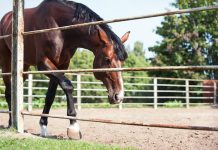
Horses and particularly ponies can live a useful, active life until quite an old age. Older mounts can be valued as schoolmasters for less experienced riders, and have important roles as paddock companions too.
But just like we humans, older horses can be more prone to certain health conditions as they age. One of these is arthritis, and another we have to be particularly aware of is Pituitary Pars Intermedia Dysfunction (PPID), which is often still refereed to by its previous name, Cushing’s Disease.
Increased age seems to be the only factor that increases the risk of PPID, with about 20% of horses over 15 years having the condition – this increases to 30% of those over 30 years old. It only rarely diagnosed in horses under 10 years of age.
What is PPID?
The cause of the signs we see in a horse with PPID is in the brain. The disease itself is classed as a slow, progressive degenerative disease, which impacts specific nerve cells (dopaminergic neurons) in the brain. These neurons are involved in controlling other cells, called melanotropes, and as a result, the latter are able to overgrow, reproduce and expand. These overgrown cells produce large amounts of substances that trigger changes elsewhere in the body.
What are the sign to look out for?
There are quite a few signs that can be noticed in a horse or pony with PPID. Some are more common than others; some appear early in the courses of the disease and some later. Not all horse with PPID will show all of the signs. Signs to look for include:
- Long hairy coat
This is one of the main classic signs we see in a horse or pony with PPID. The coat is long and often fails to shed in summer, or has delayed shedding. If you notice a change in the shedding pattern of a horse or pony in their teens, then it is definitely worth talking to your veterinarian about testing for PPID, as there is not much else that causes this change.
- Patchy changes in hair colour, patchy areas of long hair and patchy shedding.
As well as a long hairy coat, horses and ponies with PPID can also get changes in hair colour, patchy areas of long hair and patchy shedding. It doesn’t have to be all over.
- Change in attitude/lethargy
Horse and ponies with PPID may become a bit lethargic and seem to lose a bit of their zest for life. This may be assumed to be a normal part of ageing, but treatment can help return their natural temperament and enthusiasm.
- Poor performance
This may be a much more subtle sign before any of the more obvious signs and will be something that the owner/rider will pick up on before anyone else. Obviously, a drop in performance can be due to lots of other things but, if a horse is in their teens and shows a drop in performance, a PPID test may be indicated after an examination for lameness, heart and respiratory problems.
- Laminitis
Recurrent laminitis is one of the life-threatening problems and signs associated with PPID; sadly it can be the cause of horse and ponies having to be euthanized if the laminitis cannot be got under control. A horse or pony over the age of around 12 years who is having episodes of laminitis should be tested for PPID as well as Equine Metabolic Syndrome, so the best course of treatment and management can be decided. Laminitis will show up as sore feet, horses walk with a short, stilted gait, they walk better on soft ground than hard, they often rock back on their heels and may lift one foot after another, shifting their weight to try and relieve pain. It is important to get veterinary attention for this, as otherwise changes can happen in the hoof which become permanent.
- Loss of muscle tone, especially along the topline
This is another sign that we may consider a ‘normal’ part of ageing, but horse lose their muscling along the topline at a much younger age if they have PPID. They can eventually develop quite a big pot-bellied appearance too.
- Abnormal sweating
PPID is strange in that it can cause both increased and decreased sweating in different horses. In tropical climates, it can decrease sweating so much it reduces a horse’s ability to keep cool, and conversely in more temperate areas there can be too much sweating and horses will continually have a damp coat. Both of these can cause management challenges and are a sign to be aware of, that may be caused by PPID.
- Recurrent infections and delayed wound healing
Horse and ponies with PPID are more susceptible to bacterial, viral and parasite infections. So, a horse may have a frequent runny nose or cough, they may develop a sinus infection with discharge from one nostril or may have itchy skin due to lice. They often heal from wounds slower than normally too.
- Weakness of tendons and ligaments
This is something to bear in mind if an older horse or pony is having tendon or ligament issues – it can be as a result of weakening due to PPID.
- Infertility
This will obviously only be noticed if you are actively trying to breed from a PPID mare. We do breed mares at older ages these days (as long as they are fit and healthy) so one consideration in a mare who has been very fertile and has a drop in fertility is that PPID is affecting her.
- Increased thirst and increased urination
This may be difficult to notice if a horse is out in the paddock with an automatic filling water trough but one sign that tends to appear later on is an increase in the amount of drinking, and a corresponding increase in the amount of urination.
- Neurological signs
These are not that common, but sometimes we see neurological signs like blindness, seizures and a wobbly gait associated with PPID.
- Fat pad above the eye
A bulging fat pad above the eye can quite noticeable in some cases, and is due to fat being distributed abnormally.
- Inappropriate lactation
This means the mare is producing milk when there is no reason for her to be doing so! This is not common, but I have been involved in the diagnosis of a mare that came to us for investigation after she was producing milk randomly. She had no other signs of PPID but was in her late teens, and turned out to have it – which was the cause of the milk production. It just shows how variable the signs of PPID can be.
Diagnosis of PPID

Clinical signs are very important in diagnosing PPID. In general, there are hardly any medical/veterinary tests which are 100% accurate all the time. Researchers aim to develop the most accurate tests they can and reduce both false positives and false negatives.
When we test for PPID, we get a value along a range. Cut-offs have been decided to give an answer of yes, it is PPID, or no, it isn’t, but then there is a grey area in between, called the ‘equivocal zone’. If the result is in this grey zone, we are not certain if it is positive or negative.
Testing in autumn is recommended, as there is a bigger difference between the positive and negative test results, but vets should also use the clinical signs to help decide if treatment is needed. If the result is in the grey zone and there are typical clinical signs, then the horse should probably be treated as if they have PPID. If they don’t have really obvious clinical signs, then it may be an option to repeat the testing in another six months or so. This all depends on the individual case, and should be worked through with your veterinarian.
Horses and ponies that have been diagnosed with PPID should also be tested for insulin dysregulation, as high levels of insulin in the blood lead to laminitis.
Treating PPID
There is only one equine licensed drug treatment for PPID at present, and treatment is lifelong. The medication is used along with an optimal health management programme to give the best quality of life possible to PPID horses and ponies .
The medication, pergolide, was originally developed to treat Parkinson’s disease in humans, and is now licensed for veterinary use under the name Prascend. It comes in the form of a tablet, given each day. The tablets act to keep the melanotropes under control, and stop them over-growing.
Studies have shown that Prascend improves the signs seen in over 75% of diagnosed cases. It does take a while for the signs to improve – usually a couple of months but sometimes up to a year.
What are any side effects?
The main side effect noticed is the horse temporarily going off their food. This is a problem for a few reasons, including the fact it is difficult to hide the medication in food if your horse doesn’t want to eat it. Between 16 and 33% of horses get this side effect; sometimes the dose will need to drop for a while until it settles down (this must be done under veterinary supervision). Usually after a few weeks, the horse’s appetite will be back to normal.
Less common side effects from the drug are depression and diarrhoea. Again, talk to your veterinarian if you see these signs when starting your horse on the medication; it will likely need stopping and be re-started at a lower dose.
A word of warning: Don’t crush the tablets, as there is a risk to your own health if exposed. Pregnant or breast-feeding women should wear gloves when handling Prascend, and be very careful that your dog does not eat any tablets (which can happen if you hide them in a treat). Contact your vet immediately if this happens.
Management

The four key cornerstones of a health management plan, for older horses and ponies whether or not they have PPID are dental care, hoof care, nutrition and parasite control.
In the case of PPID I would add in skin care and temperature control, as they can’t adapt to changes in temperature as well so may need clipping in summer and covers in winter.
It is best to develop an overall health plan with your veterinarian that is individual for your horse or pony to give them the best quality of life.
In conclusion
Horse and ponies with PPID can be managed and continue with a great quality of life. Early diagnosis will help with a good outcome. As an owner/rider looking out for potential signs, testing if advised and then monitoring when on treatment is really important for the best outcome.






